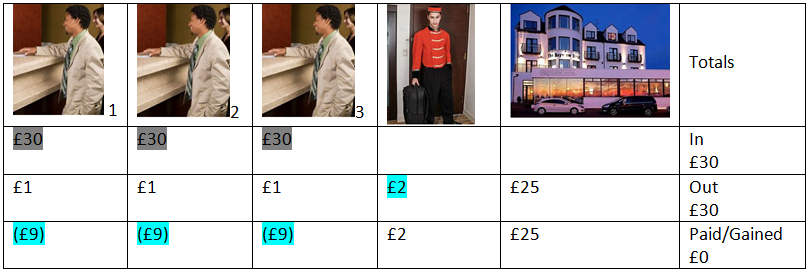This is a puzzle I’ve known since I was 10, and then yesterday a friend tagged me on it on Facebook. The solution has now been added to the post. Try answering it first before looking at the spoilers!
OK – Here is the answer!
The skill in solving problems like this is noting down the information you have and trying to ignore any misdirection. And boy, does the setter of this problem go in for misdirection!
And if you are thinking, that means bringing in skills learnt in an English comprehension class, you’d be right. School subjects may be split between Maths, English, Science, History – but in life things are never so simple. Actually I like to persuade students to write their answers in full English sentences, especially in problem solving cases.
In this situation, we have a situation involving some money, and there is money coming in (the money that each guest pays at the start) and money coming out (to the guests, the hotel and the bell boy).
Each Guest pays £10. That’s £30 ‘in the system’
But who has this money at the end? The hotel has £25. The bell boy keeps £2. Each of the guests has £1 return to them by the bell boy. That is a total of £30 (£25 + £2 + £1 + £1 + £1)
Or if you prefer lets look and gains and losses. The guests have spent £9 each, making £27. £25 goes to the hotel, £2 to the bell boy. A total of £27. Gains = Losses. Just as we’d expect.

So lets remind ourselves of the question. This asked us to add the £9s that the guests paid in and £2 the bell boy kept. But these numbers are from different parts of the question! (As highlighted in grey and blue) There is really no reason why they should be added. The fact that the total came close to £30 was a coincidence (or not, since the questioner chose the numbers to confuse!)
So in summary, ignore the last paragraph until you have come to your own understanding about the ins and outs. And then you won’t fall into the trap of adding an ‘in’ amount to an ‘out’ amount.